2016-05-31
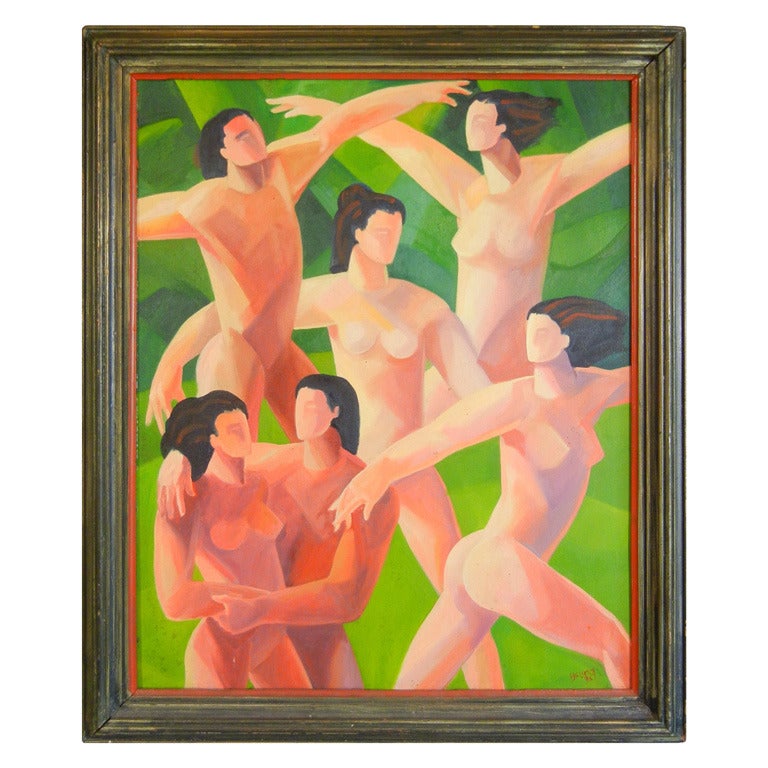
Simply signed ‘Young 96’, ‘The Dancers’ is a prime example of the American Expressionist movement which came of age in the 1930s. Abstract Expressionists were later recognised as the first truly American Avant Garde artform. Most of the artists associated with American Abstract Expressionism matured in the 1930s but the style never went away and was alive and well late into the 20th century, as evidenced by this painting.
The dancers in this painting are fluid and show freedom of movement, much like nudists feel when throwing off the trappings of the everyday world as their clothing comes off after a long day of work. Most of us want the freedom to do our own thing anyway, so freeing the body of its textile covering is the most freeing experience a human being can experience. The body’s pores are exposed to the air and hungrily absorb the molecules that keep us healthy. The skin, the body’s largest organ, welcomes the gentle breeze coming in through an open window in summer and, if you’re lucky enough to have a place where you can lie out in the sun in the nude the body eagerly takes in the sunlight and converts it to Vitamin D, one of the most important vitamins known to mankind. Be free – toss your clothes, dance and relish the ease of movement unhindered by the artificial covering we are forced to put on our bodies every day.
2016-05-29
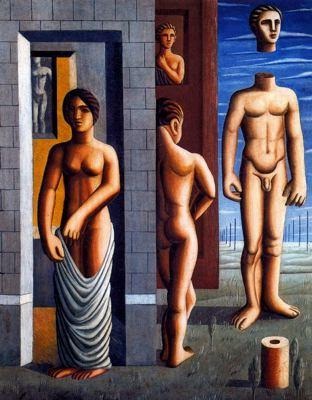
When all of life and civilization turn upside down and inside out, and events occur that make no sense at all, there is a desire to throw out everything we know and believe and throw out all existing practice and all tradition and start again. If you are a poor person, with little political or economic influence, such as a young artist, then perhaps the best thing you can do is to abandon all the ideas and techniques your professors and parents taught you and start over from the basics. Thus it is that during and after great societal upheavals such as World War Two or the Industrial Revolution we see new art movements springing up, like Surrealism. After the First World War, the great influenza plague, and with the Great Depression starting, ordinary organizations and ordinary objects had taken on new meaning and purposes. The Surrealists did the same in their art, juxtaposing ideas and objects in ways that laid bare psychological meaning so as to evoke emotional and intellectual reactions in the viewers. Artists such as Salvador Dali and Rene Magritte mixed technically adept and realistic renderings of everyday objects in ways that violated convention and expectation. This hugely influential movement influenced writing, politics, art, and even film and spawned a number of follow-on and reactionary movements that persist to today.
Most anyone who has visited a nudist resort has experienced that moment when their world view just takes a somersault flip, breaks into five pieces, and falls back together again in a completely new way. There is nothing like standing nude at a billiard table in the woods discussing astrophysics with a body-painted thirteen-year old to help you look differently at your life. Plunging into naturism can be a good way to mash the reset button on reality, and it can come with a whole raft of beneficial side effects, such as a greater focus on diet, a more open mind when discussing politics, an enhanced appreciation for other cultures, and a deeper understanding of the life cycle and epidemiology of the mosquito. I think we can all agree that, at least for the present, nudism is not a lifestyle for everyone (yeah, we all have that one relative …) but if you are finding yourself in a rut, or if your whole life has gone topsy-turvy, then perhaps you need to stop trying to make sense of it all and just get away from it all by taking it all off in the company of men and women who don’t care that they will never entirely understand you.
2016-05-28
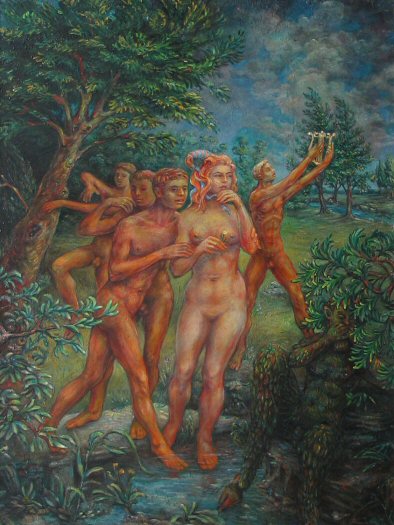
It is the nature of humans, or at least human academics, to group and sort and categorize; we love to put things into neat little boxes. Life, and art, and artists, often do not cooperate. Is a particular work Cubist? Surrealist? Realist? Expressionist? Especially in the twentieth and twenty-first centuries, when art styles have changes so much and so fast, it can be hard to place an artist in a particular era. Artists are not born, they are made, and that process takes time and covers a span of time. Any one artist may see a particular style that may appeal to them and may pause there for years, creating works that may not longer be in style. That is one way that art styles come back into style, actually. At the end of the day, it is best to judge artists by what they actually do and how well they do it, and to judge art by how much we like it.
Nudists are just like any other humans. They eat, they sleep, they put their pants on one leg at a time. They make mistakes, and sometimes those mistakes are whoppers. It is no secret that many bad actors try to conceal themselves in the nudist movement. It is a constant struggle for nudists to find these criminals and expose them, without allowing our good work and best efforts to be identified with their crimes. This constant vigilance can sometimes make newcomers and old timers alike feel persecuted and unwanted, especially if they are male, older, and single. In areas where there are public nudist facilities this is much less of a problem, as these facilities are typically patrolled by professional law enforcement agents who are used to the idea that a crowd consists of many good people with one or two bad actors mixed in. We all want to be judged by who we really are, not as a casual observer perceives us. Let us all work together to increase the number of public naturist venues, and take care to judge nudists by who they are, and by what they actually do, and not just by the face of the latest headline.
2016-05-27

To listen to some people talk about the Impressionists, you would think they invented the idea of depicting light in art, but as early as the fifth century BCE the Greeks were both using and discussing “shadow-painting”, or the use of light and dark to illustrate the volume and curvature of a three-dimensional figure in two dimensions. The Italians expanded this idea further into “chiaroscuro” (“light-dark”), a technique which uses extremes of light and shadow across a depiction of a single object to create a sense of shape and drama. Other art techniques involve a careful study of color, which is then used to show how light interacts with materials at different intensities and angles. Artists such as Maxfield Parrish would use tinted layers of transparent paint (or “glazes”) in their work. The light would penetrate into these layers and be modified before being reflected back out, thus lending a visual impression of depth and a sense of inner light to a painting. Such art can not be properly viewed in a photograph, but can only truly be experienced in person.
Nudists did not invent the idea of being natural in nature; since the Garden of Eden people have known the power of social, non-sexual, mixed-gender nudity. The holy texts of the Abrahamic tradition, common (if not entirely identical) to Jews, Christian, and Muslim alike, relate how the prophets (and their sons) would preach in the nude, illuminating their words with openness and candor. Medics and caregivers in all ages have encouraged their wards to cavort nude in the sun, well before science confirmed the positive effects of sun-synthesized vitamin D. Light is even used as a metaphor for good and freedom, and anyone who has enjoyed the freedom of a legal nude beach knows the joy of sunlight on bare skin. We love to see art of naturism, and we hope you enjoy the art we present in this blog, but such light can only truly be experienced in the naked flesh. Step out of the shadows, cast off your clothes, and step out into the light.
2016-05-25
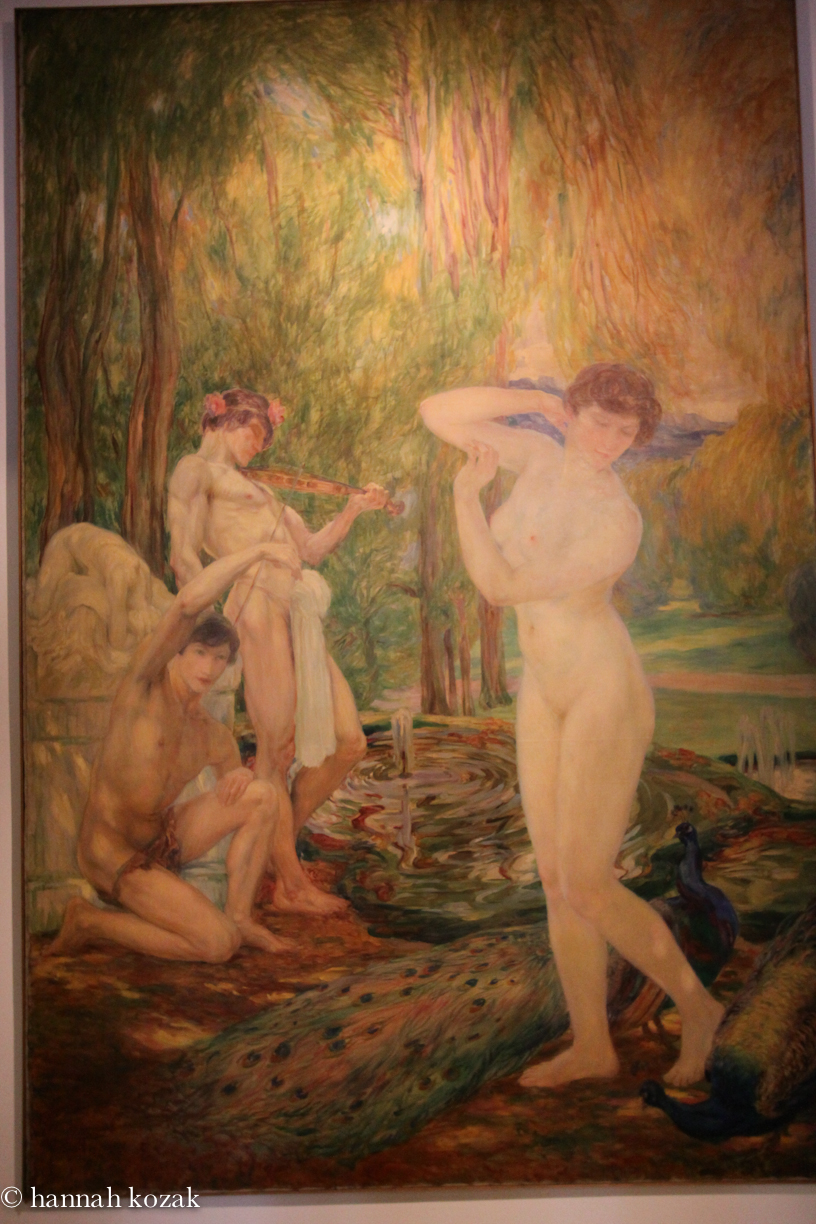
There is a stereotype in the United States today of the bohemian artist, poor and on the fringes of society, always struggling with the conflict between the natural human desire for stability and intimacy and the artistic demand of truth, exploration, and freedom. Anyone who works in or frequents venues for artistic expression knows any number of people, old or young, who fit that description. This stereotype is reinforced by the biographies of artists from ages past. Clementine Helene Dufau could easily have been an artist who some would consider eccentric. In a moralistic, male-dominated age, she was a painter who painted the nude, male and female, and who advocated for women’s rights at a time when the women’s right’s movement was just beginning. She suffered from poor health and a somewhat tumultuous love life. She submitted art to the famed Salon, and received only lesser accolades. To view her life through this lens, however, is to potentially miss the larger picture. She DID receive awards for her work, unlike many artists who lived and worked in her time. She had a very productive career and produced many fine works of art that are still being reproduced today. She adapted and grew artistically to adapt to the changing tastes in art and was hired for commissions along with other well-known artists. Her life was anything but marginal.
Many in our society view naturists as people who live on the margins of society, and we all know someone (or two) who certainly fit that mold. The great thing about nudism is that naked people lose those traces of class status that can separate us such as jewelry or fine clothes. What we cannot lose, however, is how we behave in public and how we treat other people. Considerate and polite people are high-class regardless of whether they are dressed or not. It is important for nudists to uphold high standards of interpersonal relationships regardless of naked they are, or are not, because non-nudists will judge our movement by how we treat them every day, and not just by how we act when we all get naked in nature.
2016-05-24

In 1934, the German firm BASF created a new chemical. It was a dispersion of acrylic resin, and by the mid 1940’s it was being used as a medium for paint. It used mineral spirits as a solvent. Blending the characteristics of oil paints with new and unique qualities, it was adopted by a few artists such as Roy Lichtenstein, who blended them with oil paints. The toxicity of the mineral spirits limited the application of the new media, however, and it was not until the creation of water-soluble acrylic paints in the 1950’s that acrylic paints truly saw their debut as an artist’s paint. With the ability to be used like oil paints, like watercolor paints, like tempura paints, or like no other paint out there, acrylics have become one of the most, if not the most, popular art media. It is available in a glossy, matte, or semi-matte finish, as a clear glaze, as thick paste, and in nearly every color available. Safe enough to be used by children, it dries fast but can be washed off little hands (and even clothes, if you catch it quickly) with soap and water, yet it is durable and flexible enough to use used by professionals. The switch from mineral spirits to water as a solvent opened up a new world for artists who paint.
Water has been called the universal solvent, and humans have been drawn to it for as long as humans have existed. The sound of gently running water or soft rain can lull a nervous body to sleep, and cities and civilizations spring up by rivers, lakes, and seas. Surveys show that a quarter of U.S. citizens have gone skinnydipping, and three quarters of them feel it is acceptable, and until the 1980’s some primary and secondary schools held swim classes where the students swam in the nude. Nude swims can be found around the country, and nude beaches are still legal in some states (although the number is shrinking). Water brings us together and offers a fun reason to rip off all those stuffy clothes and get naked in nature, or at least get nude in the water. If you have never tried it, go do a search for your local naturist organization and ask them how to find a place to swim nude. It will open up a whole new world for you.
2016-05-23

For the novice painter, painting is applying wet paint to a substrate and allowing it to dry, so that the color of the paint can be seen. More experienced or educated artists know that some paints also are transparent to a degree and can change the color of light that passes through them. This leads to a slightly different technique, where an opaque base is laid down, which reflects a particular color of light, and then covering that base color with different thin, colored glazes, which allow light of certain frequencies, or colors, to pass through. The result is a richer, deeper color that can take on almost gem-like qualities. Hans von Marées used this technique, as did Maxfield Parrish. It is said that many Parrish paintings can never be properly photographed or reproduced in print because of this and must be viewed in person to properly get the full effect.
Every human that has ever lived has had an effect on society, however small. There are some philosophies of life that place a great value on having an effect on society. As humans interact with each other, our minds learn and adapt, and it is possible to consciously mold and shape how others see the world and interact with it. Nudists probably have a greater opportunity to do this than the average person, because we are more rare (although not nearly as rare as some would say). Use this power wisely. Be a gem in a world of gravel. Alter the lives of the people who pass through your influence. Don’t just be a person who wants to get naked; be a person who knows the value of nudity, the value of being natural in nature, the value of stripping off artificial barriers and classifications and being open, honest, and genuine. Get naked and change the world for the better.
2016-05-22
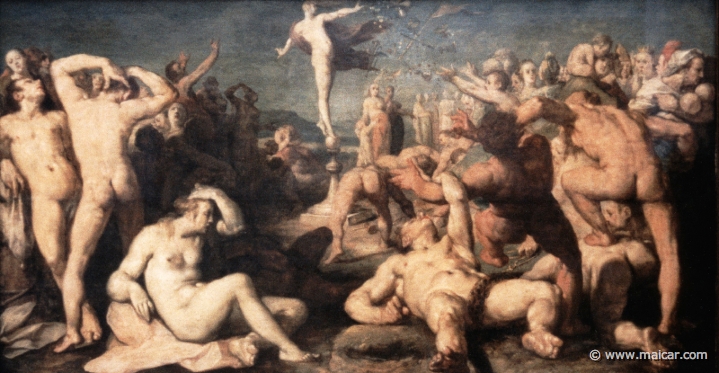
Born in 1562, Cornelis was born into a wealthy family in the Dutch city of Haarlem . His parents had fled the city during the Spanish siege (December 1572 – July 1573), and Cornelis was entrusted to the painter Pieter Pietersz (v. 1540 – 1603), who raised and taught him art. He spent some time in France and a year in Antwerp with master painter Gillis Coignet nad returned to Haarlem around 1580, where he settled permanently. In 1583, he met Cornelis Hendrik Goltzius and Carel van Mander and founded the Academy of Haarlem. One his idiosyncrasies was that, as noted by Jacques Foucart, his nudes often had dirty soles on their feet and his painting of Venus has black nails.
Nudists are well acquainted with dirty feet. It’s a simple fact that if you walk around nude your feet are going to get dirty, but nudism is NOT a dirty word nor a dirty way of life. It is freedom – freedom from the clinging of textiles, freedom of movement, freedom of expression and freedom of choice. Basically, nudism represents everything we cherish in America, but most people don’t understand that and as a result we have to fight for our right to express ourselves naturally, unlike in Europe. Most cities in America either can’t or won’t ever hold a World Naked Bike Ride, like they’re currently organizing in London (you can donate to the cause at https://www.paypal.com/cgi-bin/webscr?cmd=_s-xclick&hosted_button_id=ZC3PWTT6FB7J4). Most cities in America won’t have body painting exhibitions or large groups of painted but otherwise nude people as they do in many parts of Europe. The time-honored practice is done at private events and even for Sports Illustrated. We need to put forward a concerted effort to change the mentality of the American public where nudism and naturism are concerned and to educate the populace to the healthy aspects of the lifestyle and instill the strong moral values that are held by the vast majority of people who live it.
2016-05-21

Humans instinctively know what other humans look like. This is one of the reasons that figure art is so daunting; even a child can look at a representation of a human and know how accurate it is. The key to an accurate representation of a human is proportion. Every society and every human has slightly different standards for what a perfectly proportioned human looks like, but when a figure is drawn well out of the range for “normal” anyone can tell. Proportions change from birth to adulthood (children have proportionately larger heads and smaller limbs), and artists use this very intentionally, using some of the proportions of children when depicting adults so as to make the viewer feel more sympathetic towards the figure. Males and females have different proportions as well, with females tending to have shorter torsos and longer legs (in addition to other, more obvious differences). Knowing the proportions of the human figure and using them correctly is an essential part of art.
Societies have always understood the need for proportion and balance in the lives of individuals. Human resource departments talk about “work-life balance” and police agencies and militaries talk of “proportional force”. Sayings and teachings about moderation abound in the holy wisdom writings of almost all religions. As nudists living in society we must find the correct ratio of nudism to textilism, of activism to hedonism, of conservatism to exploration. We represent naturism to our families, friends, coworkers, and strangers that we meet. Obviously we will get naked if we are nudists, but we do not want to strip off willy-nilly and scare the horses. If we are too adventurous, naturism looks like simple abandon. If we spend too lavishly, naturism will look like it is only for the rich, and if we cannot control our drinking then it would be best if our activities had no alcohol present. Finding the right proportions is as essential to being a success as a nudist as it is anywhere else in life.
2016-05-19
Located at the 48th Street entrance to 1 Rockefeller Plaza, this bas-relief Art Deco sculpture is made of polychrome and gilded limestone and shows Bacchus the god of Wine with a coterie of subjects. Art Deco was a very popular genre in the 1920s and 1930s and is perhaps most recognizable as Egyptian-influenced themes in everything from the neighborhood Greyhound station to the tallest skyscrapers.
‘Joy of Life’ is also how naturists/nudists view their daily existence, as the trappings of the mundane world are thrown off with the clothing at the end of a particularly stressful day at work, and the freedom of movement rejuvenates the tired body.
2016-05-18

From the Museum of Modern Art in New York City, this woodcut was created in 1909 but wasn’t published until the following year. A group of German Expressionists, the Brücke group’s portfolios were issued every year from 1906 to 1912, with each year highlighting one artist. This image, of bathers enjoying nature, is from the 1910 portfolio.
And isn’t enjoying nature what it’s all about? Nudists eagerly look forward to the summer months when outdoor activities can be engaged in.
2016-05-17

‘Art Nouveau is considered a “total” art style, embracing architecture, graphic art, interior design, and most of the decorative arts including jewellery, furniture, textiles, household silver and other utensils and lighting, as well as the fine arts. According to the philosophy of the style, art should be a way of life. For many well-off Europeans, it was possible to live in an art nouveau-inspired house with art nouveau furniture, silverware, fabrics, ceramics including tableware, jewellery, cigarette cases, etc. Artists desired to combine the fine arts and applied arts, even for utilitarian objects.’ (https://en.wikipedia.org/wiki/Art_Nouveau)
Similarly, nudism/naturism is a ‘total lifestyle,’ however, devoid of the trappings of a traditional lifestyle. In this way it is in direct opposition to the nouveau movement in that it is not decorative, though it is utilitarian. It should ideally inform the way we treat others (because under our clothes we’re all the same), our political views (advocating for greater personal freedom), our views on ecology and sustainability as we want to have natural spaces where we can experience nature naturally.
2016-05-16

It usually comes as a bit of a surprise to many students of art when they first realize that not every painting or sculpture is intended to be beautiful, because art and beauty are so tightly connected in the collective consciousness. The study of what is beautiful and why it is beautiful was begun in antiquity and has even spawned a number of scientific studies. The Greeks felt that the root of beauty was mathematical, and in the Age of Reason the idea of variety in unity was favored. The Romantic period brought out the idea of beauty as an aspect of the sublime, and in modern society beauty has been linked to the idea of justice. Science has shown that, in humans, beauty is simultaneously an absence of signs of poor health, such as irregularities or asymmetry, and a mix of features and proportions that approaches the perfect average for a healthy, young human. The word “young” is important there, because beauty is often linked to the appearance of fertility, particularly when discussing the proportions of the female body. It was this reliance on our built-in, biological definition for beauty that helped inspire the anti-aesthetic movement in the twentieth century, a movement which was later soundly rejected.
It is no secret that physical attractiveness is both a great blessing and rather unevenly distributed. Good looking folks get paid more, are less likely to get arrested, convicted, or do prison time, and are perceived as simply better people than those with merely average looks. As naturists, we need to recognize this. The bodies we see in represented in art are generally not representative of the bodies one actually sees at a resort or beach, or in the mirror, any more than the photos of food as shown in the ad are representative of the food as delivered on the plate at the local restaurant. If nudism is to be successful, we need to find ways to make naturism accessible and enjoyable to people with merely average looks, as well as “less than average” looks. If the joy and blessings of naturism are reserved only for those who are young and attractive, then eventually everyone will find the doors closed to them, and that can get ugly real fast.
2016-05-14
What do you do when everything has been done before? When all the challenges have been met, when every art and technique has been perfected, when the absolute pinnacle of practice has been reached by those who have gone before you? Why, you start to make stuff up! This is what the Mannerist artists of the late European Renaissance did. The artists that preceded them, culminating in Michelangelo, the incomparable painter of the Sistine Chapel in Rome, had perfected classical art with its harmonious composition, flawless shading and exact draftsmanship. With “nothing new left to do”, the young artists that followed just simply started making stuff up. They started exaggerating the poses, the figures, the drama, the contrast. They left behind the studied realism of the Renaissance and started to imaging beyond the real into the ideal, and eventually into the baroque and even grotesque.
As a archetype of Northern Mannerism, Joachim Wtewael knew what he wanted, and as a wealthy merchant he had the time and money to make it. What he wanted, and what his clients wanted, simply, was beautiful and meaningful paintings of naked people. It was simple, really. They knew that naked people could be very beautiful, and that the nude human form could hold and expose vast symbolic meaning in an appropriate setting. They were not content with uninspiring, simple nudes, and they were not satisfied with merely pretty figures. They wanted drama, and they wanted action, and they wanted meaning, and they wanted nudes, and Joachim painted all of that. Even to this day, if well preserved, they are like gems, filled with mysterious color and light. Let’s be honest; we all like beautiful naked people — we are programmed to like them — and we want meaning in our lives. So enjoy the painting. You’re welcome.
2016-05-13

Landscape as a genre in art is “modern”, in the sense that it does not appear in antiquity, with “pure” landscapes not appearing until 1500 BCE. It was the Chinese who really took the landscape from being a mere background and elevated it to its own genre. “It has been said that the role of landscape art in Chinese painting corresponds to that of the nude in the west, as a theme unvarying in itself, but made the vehicle of infinite nuances of vision and feeling” (William Watson, Style in the Arts of China, 1974, Penguin, ISBN 0140218637). There are entire art movements dedicated to the landscape, such as the Hudson River School, and Romanticism elevated Western landscapes to a spiritual artform, featuring the power and mystery of the mountains, the forests, the weather, and the sea.
Anyone who has spent time in natural au natural knows the power and mystery of nature. The practice of naturism is indeed a spiritual thing. It can seem artificial at times, this casting off of clothing outdoors, if you are someone who was raised in our very structured, cultured, protected Western civilization, and indeed nudism seems to be a modern phenomenon, starting in the early 1900’s. The deeper reality is that a casual acceptance of the human form is really the norm, and arose in reaction to the cultural repression stemming from increasing urbanization and industrialization. As our corporate overlords drive us harder and harder towards a commercialized and Photoshopped homogeneity, the fortunate ones who seek solace in naked nature will sense the greater connectedness and reality that comes from the land.
2016-05-11

Mythology has inspired many artists throughout the years and has provided source material for thousands of paintings and sculptures. So popular has mythology become for source material that in some cases it has taken on a life of its own, with later artists ignoring the original source material and basing their works on the art of previous artists. Myths have continued to be created in the modern times, both through outright story-telling (ie. comics, movies, fiction, etc.) or through the gradual (or intentional) exaggeration of noble (or ignoble) exploits of the famous and infamous. For artists in more puritanical eras and areas, mythology has served as a justification for the depiction of less favored topics, allowing the artist to flaunt the governmental opprobrium of such topics as dissent, nudity, passion, or religion.
Nudists have their own mythology. If the grass is greener on the other side of the fence, then the water is also cleaner and warmer, and the longer ago an event happened the larger the crowd grows and the nakeder the participants were. We read of the heroes of naturism such as Adolf Koch, Fidus, Lee Baxandall, and Walt Whitman, but we do not tend to celebrate the arrests, the years of obscurity, the small beginnings, middles, and sometimes even ends. The swimming hole always seems smaller when we show up in the late spring every year, and we start to wonder where all the young people went, forgetting that those young people are still coming, they just all grew old. There is a danger in mythology, especially if it becomes a substitute for efforts to build the future and if the perfect becomes the enemy of the merely good. Myths are important and inevitable; let us use our myths to inform and shape our future, not replace it.
2016-05-10
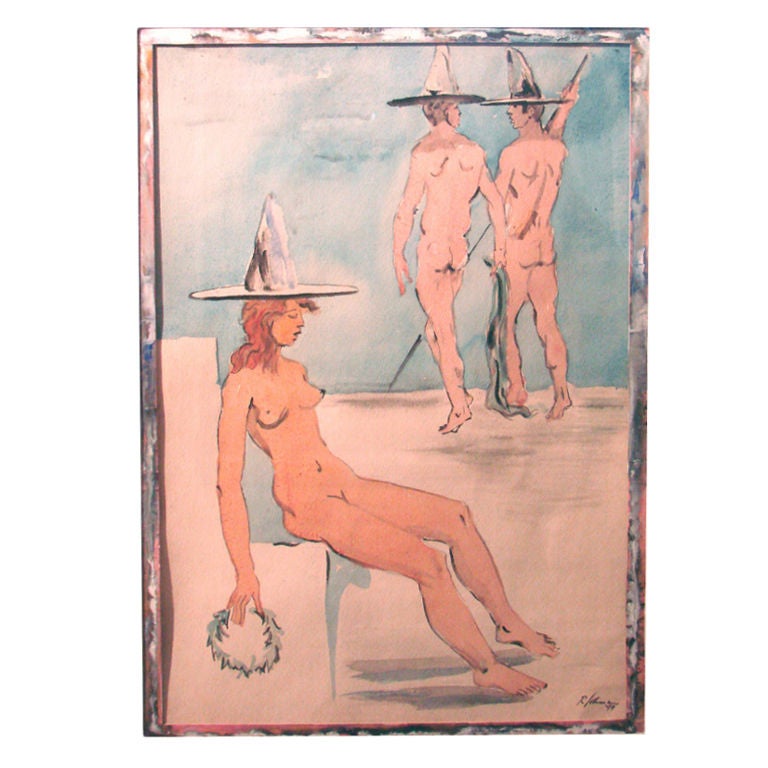
One of the seminal figures in the early twentieth century was Sigmund Freud, and his writings and practice inspired many new movements in medicine, science, and culture. The Surrealist movement was one such movement, started in the 1920’s in Europe. An attempt to reconcile the vivid world of vision and dream with the fact and stuff of reality, it uses very realistic technique juxtaposed with often nonsensical pairings and composition. It is almost as if the painter was trying to paint what we all experience in our dreams. Grown from both the Dada movement and the automatic writing movement, it was many artist’s attempt to find a way to express the confusion and conflict created in society by World War One, the displacements of the modernization of the world economy, and the massive epidemics in the early 1900’s.
Many people in our society have just stopped trying to make sense of their own lives, and have moved on to just living them, paying no attention to convention or the opinions of family and loved ones. We look on in morbid fascination at the spectacle while sometimes secretly wishing we could live as free and unconcerned about the consequences. It takes a measure of such bravado to be a nudist; if you care too much about what others think, you will never have the courage to doff that encumbering fabric and feel the breeze on your bare skin. There is a rightness about nature and being naked in it that helps reorient our lives. Most of us have to work for a living, and have to get along with people who shudder at the very idea that we are a body with parts, but equally most of us can find a time and a place where we can embrace the craziness and live out our vision of a life that makes at least a little sense in a world of utter madness.
2016-05-09

This picture is a happy mess; there are all sorts of things going on here. At the upper right there is blue sky, with not a whole lot there. Off on the lower left there are these dark areas under the pier, again mostly blank, save for the figures before them. In the middle is chaos; dozens of bodies, in various states of undress, in various poses, and in varying degrees of detail. Some are naked folks lying on the beach. Others are undressing, others are jumping into the water. There are those two ladies on the lower left changing into their suits, and there is that jumble of people on top of the pier, climbing up and scrambling around. There are light areas and dark areas, square areas and areas of no certain shape at all, and splashes of color throughout. These contrasts are not in conflict; in fact, it is the very contrast of dark to light, busy to empty, and simple to complex that make this picture interesting. This is just a fun picture, with lots of different artist elements all happily coexisting together.
There are those who would love to just run off into the woods, rip off their clothes, and live like a hermit forever, not having to worry about anyone else for the rest of their lives. Most of us cannot do that, and really would not prefer that kind of isolation even if it were available. We know that not every one agrees with our lifestyle, and heaven knows we do not agree with many of the choices our neighbors, coworkers, and family make, but we try to be tolerant and get along. Often we appreciate being around people who are a little bit different … it makes life interesting. Do not be afraid to let other people know that you are a nudist. Be discrete, if you need to be, but do not be ashamed. Other folks will probably appreciate that you have a different view than they do, and we can all get along, if we try.
2016-05-08
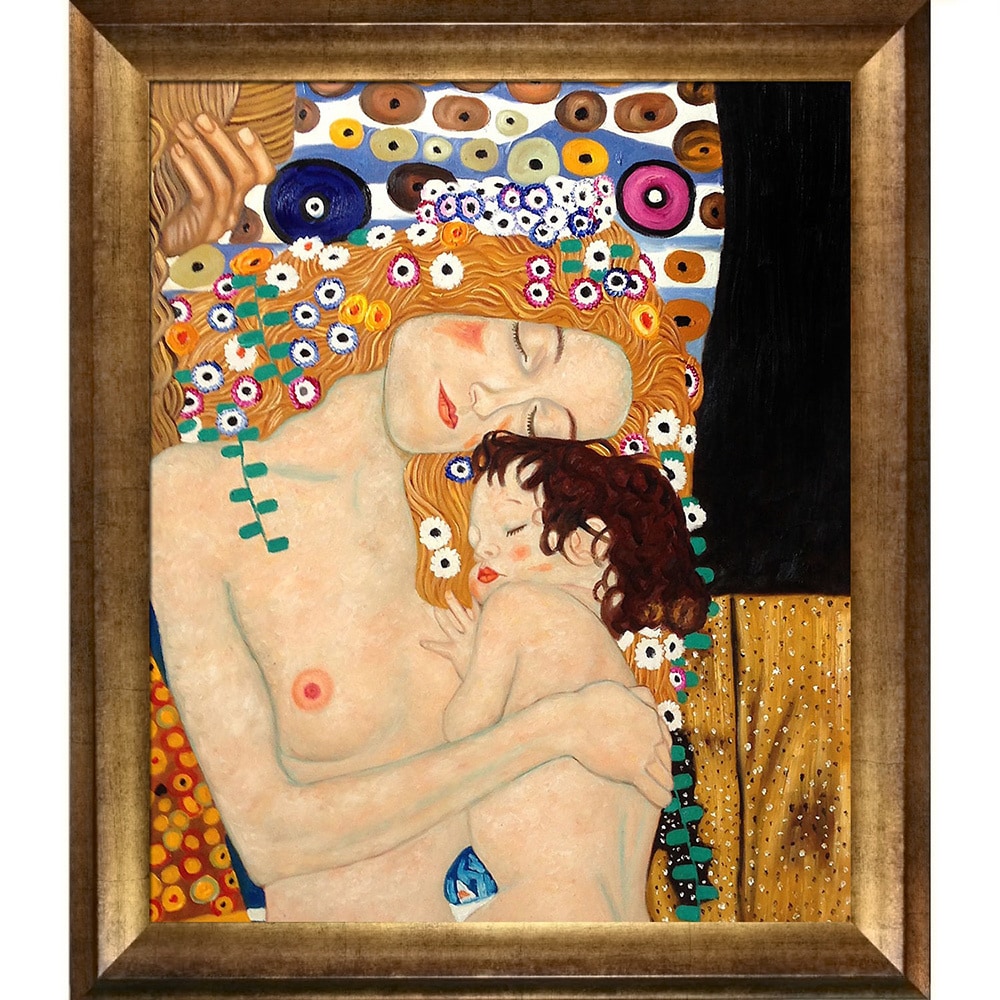
Today’s image is a tribute to Mother’s Day. Gustav Klimt was an Austrian painter in what has been called the ‘Symbolist’ style. He was very influenced by Japanese art and technique.
As naturiststs/nudists, we have to always fight to live the lifestyle we enjoy. This image shows the innocence and bond of mother and child when skin touches skin. On the other hand, we also make a connection on a completely different level when we gather at clothing optional events because each person is silently saying ‘look at me, I have nothing to hide.’
2016-05-07

Today’s image is a whimsical drawing by Victoria Davidson, who came to prominence beginning in the 1930s as an illustrator for Lilliput magazine and Picture Post. Born Lilli Ursula Barbara Commichau in Munich in 1915, an accident sidelined her from her first love, ballet, but she had always loved to draw as a child and decided to go to art school in September 1929. She won a scholarship to study fashion in Berlin and this alternated with Life Drawing, Graphic Design and History of Costume.
In 1937, what became a popular monthly magazine, Lilliput was created and Victoria was asked to contribute illustrations beginning with the 3rd edition and continued contributing for the next twenty years. Her work yielded many covers of the magazine and illustrations accompanying articles were always signed either Victoria’ or just just V’. The, when Hulton Press began publication of Picture Post in 1938, she became a regular contributor, until the magazine ended in the 1950s. She never was considered a staff member of either magazine.
As naturiststs/nudists, we have to keep up this whimsical look at life because if we can’t laugh at ourselves who can we laugh at. Nudism takes such a beating because people equate it with sex all the time when, in reality, that is simply not the case. And so we turn to images such as today’s to help keep us grounded and reminds us of the fun to be had at clothing optional events, even if we wind up with wicker marks on our bums!
2016-05-06

Public art is almost never a simple thing. Anyone who has ever read about or been involved in the creation or preservation of public art knows how complex a thing it can be. These two gilded bronze statues installed in Washington, DC, USA are an excellent example. Commissioned during the Great Depression, they were delayed by artistic decision, artistic temperament, funding issues, the Great Depression, World War Two, and the difficulties of properly casting and gilding eighty thousand pounds of bronze. Their actual creation required several acts of international diplomacy, including one carried out in secret by a private citizen on foreign soil. Once they were installed, many critics did not like them, and tried to have them relocated. Flaws in their creation resulted in three restoration projects, one requiring a complete disassembly and re-engineering. To top it all off, vandalism and graffiti have now left a permanent mark on the works. None of this changes the essential meaning of these works commissioned to commemorate the American Civil War and all who died and sacrificed in it, but it does color and illuminate it, once known.
Sometimes a cigar is just a cigar, and the basic joy of being naked in nature is essential to any humans who have to wear clothes all day long, but there is huge import to the act and declaration of being a nudist. Assuming it is even legal to be a nudist in your local area, which it is not in at least one U.S. state, finding a place to practice can be very difficult and time consuming. Declaring oneself to be a nudist can be a strain on relations, whether familial, ecclesiastical, economic, social, or political. Nudism can be expensive, especially in more conservative and urban areas. Even inside the nudist community there are factions and cliques, so that as one ages, or if one is single, or if one is gay or trans-gendered or even of a different race, events may or may not be open for one to attend. None of this changes the legitimacy of social, mixed-gender, non-sexual nudity, but it does color and illuminate it, once known. Let us all strive for valor, and sacrifice if need be, to preserve this freedom for which many have worked, fought, and even died.
2016-05-05
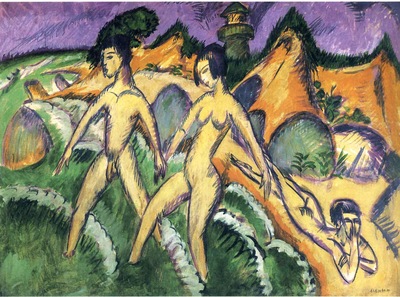
According to theartstory.org:
Kirchner believed that powerful forces – enlivening yet also destructive – dwelt beneath the veneer of Western civilization, and he believed that creativity offered a means of harnessing them. This outlook shaped the way in which he depicted men and women in his pictures, as people who often seem at war with themselves or their environment.’
Kirchner also became enamoured of Pacific Island art, primitive art, because it depicted form in a simplistic way. His figures, freuently in motion, are drawn very simply and his work contains very few if any straight lines, indicating that everything in life is fluid.
2016-05-04

Since yesterday’s image was of a feast, I thought today’s image should be the aftermath of that feast – hence the bacchanalia or the celebration of Bacchus, the ancient Greek and Roman god of wine. As is depicted in this image, revelers rejoiced in consuming the intoxicating beverage and cavorting, dancing and singing, often in the nude. It is thought that the festivals came to Rome circa 200 BC by way of the Greek colonies in the south of Italy.
Kendric Tonn is an American artist who paints in the classicist style and his works look as though they could have been painted around the time of the Renaissance and many of his works feature nude male and female models.
2016-05-03

Are you the sort of person who longs for ancient days and ways? Do you feel that art is by very nature a spiritual thing? Would you rather own a richly-colored, detailed, and sophisticated painting than the most accurate photo ever taken? If so, then you may be a Pre-Raphaelite! This brotherhood, established in England in 1848 by a disaffected group of painters, poets, and critics, was dedicated to original ideas, the study of nature, the rejection of the conventional in favor of the heartfelt, and above all the creation of just plain, awesome art. Largely a rejection of “grand manner”, the classical style of the day that neglected a close study of nature for a more idealized image. Using thin layers of transparent color over a white background, the goal of Pre-Raphaelite art is to mimic nature. Believing that freedom and responsibility were inseparable, the members believed that art was essentially spiritual and rejected the materialist realism of the mainstream art of the day.
The era of the late 1800’s and early 1900’s was a veritable cauldron of new ideas and social philosophies. One of the philosophies that emerged from this raging social stew was naturism. First expressed in the early 1890’s in India, and then further elucidated in the early 1900’s by Dr. Heinrich Pudor in Germany, early naturism was a back-to-nature movement that emphasized nudity in the sunshine, exercise, healthy eating and elimination of bad habits such as smoking. The discovery in 1919 by the German doctor Kurt Huldschinsky that sunlight could help cure rickets in children helped many realize the healing power of the sun on naked skin. In Germany naturism became such a social force that by 1932 the schools of Adolf Koch, an anti-authoritarian primary school teacher, had enrolled 70,000 students, and adults and children could be found littering the countryside in their natural, naked state. From the very beginning nudism was a spiritual and philosophical movement that has sought to harmonize the current state of man with nature through the liberating influence of non-sexual, social, mixed-gender nudity, rejecting not just false modesty but also other corrupting influences of modern culture.
2016-05-02

One of the classic stereotypes in U.S. culture is that of the starving artist, the loner, disorganized creator struggling to fit her wildly creative life into the mundane mold of average society. Often described as underemployed, disorganized, often addicted to various failed coping techniques like drugs or sex, these desperate geniuses are usually unrecognized until their art is almost fully formed, springing forth to change society, often, unhappily, after the artist’s early and tragic death. Later biographers may link the artist’s behavior to one or more mental disorders, speaking of visions (schizophrenia) and dramatic bursts of creativity followed by black depression (bipolar). Names such as Frederick Hart and Vincent Van Gogh come to mind. What these stereotypes fail to point out is that all of these characteristics were also shared by many of the artist’s contemporary peers, men and women who also struggled to fit in and thrive, but whose efforts were not later rewarded by fame and admiration. It is likely that for every starving artist whose works made their way into our canon of creativity there were perhaps a dozen others whose works ended up in a furnace or landfill, or perhaps into a relative’s guest bedroom if they had some skill. Art is often the record of struggle, grand or subtle, and expresses the common strife we all share, whether famous or not.
As members of a persecuted minority, nudists need to remember that we are not the only ones who are struggling, and that often our fellow nudists may be struggling with things that we ourselves are not. There have been many interesting studies that suggest that nudism may bring comfort and solace to many of the ills that plague womankind, such as poor self esteem. Indeed, some disorders, such as autism, seem particularly drawn to a nudist lifestyle, and if it brings relief then who are we to deny it? It has been said that not all of God’s children are beautiful — some are barely presentable. This hardly lessens the need for us to be accepting, and willing to open our doors, and maybe even hold them open, to those who some may deem the lessor members of our society. We all have our own struggles, and we have all had help. Let us remember to help others who struggle also.
2016-05-01

How about a nice ‘cartoon’ for the first Sunday in May?
Ernst Ludwig Kirchner (1880-1938) was another German expressionist painter and printmaker. He was one of the founders of the artists group Die Brücke or “The Bridge”, which led to the founding of the Expressionist movement in the 20th-century. He frequently referred to his mother’s pedigree as a member of the Huguenots and, apparently, his studio was frequently the site of nude gatherings and even casual lovemaking.
He briefly served in World War I before suffering a breakdown and was subsequently discharged from the German military. The Nazis called his work ‘degenerate’ in 1933 and, in a terrible whirlwind of destruction in 1937, more than 600 pieces of his artwork, which were stylised as almost cartoonish and which were mostly in colour, were either destroyed or sold. Though far from his usual milieu, many of his works were nudes, leading the Nazi party to give his work the title of ‘degenerate.’ A year later he committed suicide.
If you have any comments, please share them by emailing us.
My Patreon Account

We are raising money to open a studio where we can create more art!